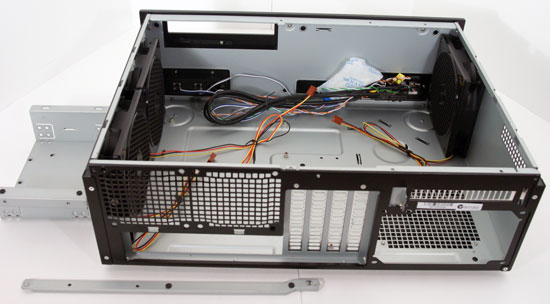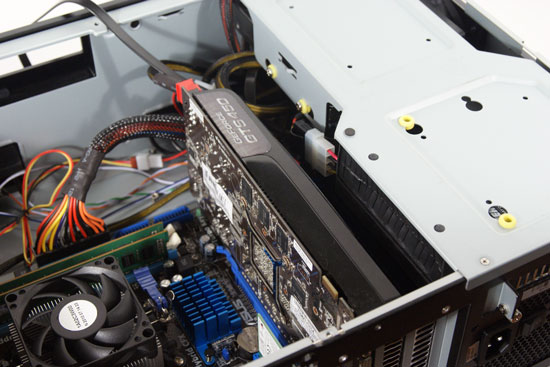SilverStone GD04 HTPC Case: Cool, Not Quiet
by Dustin Sklavos on December 25, 2010 12:00 AM EST- Posted in
- Cases/Cooling/PSUs
- HTPC
- SilverStone
- GD04
Assembling an HPTC in the GD04
When building in most cases, the assembly is fairly self-explanatory. The SilverStone GD04? Not so much. Installing my hardware in the GD04 actually resulted in my consulting the instructions that come with the case fairly frequently, and there's a reason why: SilverStone specifies a very specific order for installing components to keep cable routing fairly clean and easy.

The first thing you'll need to do is remove the trays and the crossbar, and for sanity's sake the motherboard should probably go in before the power supply does. SilverStone actually includes rubber standoffs that adhere to the bottom of the power supply, as there's a centimeter or so worth of empty space between where the unit mounts and the bottom of the case. You'll want to connect whatever cables you can and install your expansion cards, because the next step involves putting the crossbar back in.
It's at this point that you should also note the 120mm fans all come with three-pin connectors and are intended to be plugged into and controlled by the motherboard. That would be fine, but most MicroATX boards don't come with that many fan control headers (to say nothing of MiniITX), not to mention how mediocre most motherboard implementations of fan control are. SilverStone includes an adapter that allows you to plug all three headers into a single molex connector, but that also means the fans are running at full bore all the time, and you'll see why that's a problem later on. Mercifully, the fans have built-in internal grates that keep bunched up cables from getting caught in the fan blades.
After you've replaced the crossbar, you'll need to mount the hard drive or drives into the mounting tray. The tray actually supports up to three drives total: two 3.25" and a 2.5". It's probably easiest to just install one big storage drive - this is a media center case after all. The 2.5" bay does make using an SSD as an OS drive easy, however. Installing the optical drive is also pretty simple, and there's some give on it so you can line it up properly with the opening in the front. I've read that one or two users on NewEgg had to shave off part of the tray opening for their builds, but the combination Blu-ray/HD-DVD drive I have fit perfectly and without issue.

If you follow the instructions that come with the GD04, assembly actually goes fairly smoothly. The main problem is really just what a nuisance all the tiny screws can be. I understand going entirely toolless may be a convenience not available for a case this size designed for this task, but I can't help but feel like this whole ordeal could've been easier.
















68 Comments
View All Comments
cweinheimer - Tuesday, December 28, 2010 - link
Wow, really? I expect flame wars between competitors for attention, but for the writer to flame his readers? That certainly cant go on forever if you expect to keep readers. Oh, wait I see what you are doing, creating controversy so people will tune in. Definitely lame.SlyNine - Sunday, December 26, 2010 - link
They are obviously Anandtech, Your half cocked ways of pointing out weasel words and fallacies, While completely ignoring the context are baffling to me.You whip the noise floor so you can compare other unites to each other without any interference from out side sources, after all you're going to choose on based on how it performs vs. other units. Why do you want other metrics in there( Keep this in context now, you have a lousy track record) ?The noise floor should be considered in YOUR place/theatre. How will including theirs help you decide what unit is the best?
RobertR13 - Sunday, December 26, 2010 - link
I genuinely struggled to understand your question, so please let me know if I missed it all together. I understand this is anandtech, however there haven't been other case reviews here for almost 2 years, and done by another person entirely, so I was attempting to establish that these results were not comparable to anything else, which makes them of little to no value.Also, I brought up the noise floor issue, as well as the issue of the other components in the case, because without knowing these values, we don't actually know how much noise the case and fans actually generated. For all we know, the GPU fan could have been responsible for almost all of the sound measured, or the 36db measured at the side of the case could have been coming from his girlfriends blow drier in the next room. You see where I'm coming from?
MeanBruce - Sunday, December 26, 2010 - link
Robert is right dudes, if you are gonna compare, you first have to standardize!ZRohlfs - Wednesday, December 29, 2010 - link
There are a differences among the term deciBell. There are several measuring standards among the units. Two of the most synonymous are dBA and dBB. It is all how the different frequencies are factored into the measurement with typical emphasis on the mid level frequencies and a reduced empahsis on the upper and low range frequencies.still as long as we are comparing dBA to dBA results yes they are the same but really the best thing is to have the individual frequency ranges and representative sound pressure.
Just a thought.
Arneh - Saturday, December 25, 2010 - link
Great review. I'm personally a big fan of the SilverStone GD02. It's also an mATX case but you can squeeze in 3x3.5" (2 of them with vibration dampening), 1x5.25" ODD and an SSD above the ODD if you really wanted to (this isn't part of the specs but there's a gap in the tray above the ODD that allows you to squeeze in a 2.5" drive). The design is also more aesthetic in my opinion and suited for an HTPC. The two 80mm fans are also extremely quiet.mingus - Saturday, December 25, 2010 - link
I use this case and replaced the loud fans with what I thought would be quiet ones (800rpm Scythe), and it was still very audible. Tonight i unplugged all the case fans and it's doable, can hear very slightly from the sofa. I was very careful to select all quiet parts on this also.May not be right long term, will keep an eye on temps. most likely will rebuild the whole thing. Looking for case ideas, maybe gd02 who knows..
Belard - Saturday, December 25, 2010 - link
Okay, its a $100 case - so Silverstone included cheap fans.They should have done what others do, include a fan-controller that allows the user to choose how fast his fans run. With 3 HUGE 120mm fans, they simply don't need to run that fast - especially with todays cooler running CPUs.
There are low-cost solutions to fix this case.
1 - Buy an aftermarket fan controller ($10~30)
2 - Buy Antec Fans ($15~19 each) which include a 3-way switch (L / M / H).
My Antec P150 case has a single 120mm fan that runs on Medium - very little noise for a quad-core desktop system. For a HTPC... it should be even more quiet than what I have.
micksh - Saturday, December 25, 2010 - link
What is Extech SL10 sound meter? Can't find it in google. What is the minimum dBA level it can measure?At what distance from HTPC did you measure noise? Or, you think it's not important to write about? Like noise is at the same level regardless of how far you are from the source of noise?
If the noise is 36 dBA at 1 meter from HTPC it is ridiculously loud already. It should be around 20 dBA or less in order to comfortably watch movies.
Where is the analysis on what components contribute more noise? Was that case fans, CPU cooler or video card? How are we judging HTPC case without such analysis?
"These aren't loud components to begin with"
I'm sure they are.
1. I don't think EVGA was ever known for making quiet video cards. Get MSI Cyclone version and use MSI Afterburner to slow down fans. Edit BIOS if fan is too loud at minimum speed. Read ht4u.net reviews to find quiet video card.
2. What is PC Power & Cooling? How is that supposed to be quiet? Get Enermax Modu/Pro or Seasonic X or Nexus or some comparable PSU in terms of noise.
3. Get SSD for main drive and use quiet laptop 5400 rpm HDD in enclosure as a media drive. Mounted with ribbon washers, of course. Scythe SQD2.5-1000 is back on sale in US.
4. Replace case fans. Scythe Slipstreams, few Zalman resistors and you don't need to care about motherboard or fan controller. Even Antec provides horrible fans with their P desktop line targeted to quiet PC enthusiasts.
5. It may be to difficult to quietly cool 95W AMD quad core. Get lower powered CPU. And better CPU cooler maybe.
6. Read silentpcreview.com about basics of quiet PCs.
These 6 items will drive you closer to quiet HTPC. HTPC case itself can't protect your ears from loud components.
Belard - Saturday, December 25, 2010 - link
My P150 case is over 2 years old - it about 2-3 feet from me I can barely hear it (air noise)... barely a rumble from the drive & fan.(1) MSI, Gigabyte and H.I.S. make some pretty quiet video cards. I've seen a 6850 being used in normal desktop mode and it was fairly silent. I can't hear my *OLD* 4670 HIS card with its extra large dual-slot cooler.
(2) PC Power & Cooling is one of the BEST PSU companies in the world. But they don't usually make the quietest ones. Corsair or Seasonic PSUs would be a better choice IMHO.... you can't hear them.
(3) Yes... on the SSD (if possible). But 2.5" drives are not as reliable as a 3.5" drive. I have a Seagate 1TB 7200 RPM drive... I just put my head by my case - closest to the HD, I can't hear it... but more air noise. :)
(4) Agreed... many options. So much that Silver Stone should *USE* better fans or include a list of fans to use, rather than waste someone's time with useless fans.
(5) AMD stock CPU coolers generally do a fine job. 95w is typical for their performance CPUs, X3 & X4s. They do have some 45w X2~X4 CPUs which costs 20~40% more. And of course, theres after market coolers. Overall, the AMD coolers I've used in the past 4 years have been pretty good.